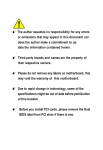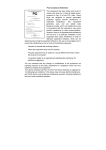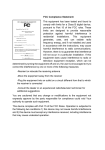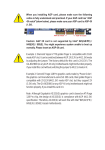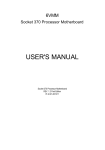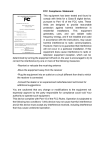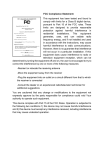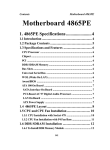Download FCC Compliance Statement: This equipment has been
Transcript
FCC Compliance Statement: This equipment has been tested and found to comply with limits for a Class B digital device, pursuant to Part 15 of the FCC rules. These limits are designed to provide reasonable protection against harmful interference in residential installations. This equipment generates, uses, and can radiate radio frequency energy, and if not installed and used in accordance with the instructions, may cause harmful interference to radio communications. However, there is no guarantee that interference will not occur in a particular installation. If this Eric Lu equipment does cause interference to radio or television equipment reception, which can be determined by turning the equipment off and on, the user is encouraged to try to correct the interference by one or more of the following measures: DECLARATION OF CONFORMITY Per FCC Part 2 Section 2. 1077(a) Responsible Party Name: G.B.T. INC. (U.S.A.) Address: 17358 Railroad Street City of Industry, CA91748 Phone/Fax No: (818) 854-9338/ (818) 854-9339 hereby declares that the product Product Name: Mother Board Model Number: GA-7DXE Conforms to the following specifications: FCC Part 15, Subpart B, Section 15.107(a) and Section 15.109(a), Class B Digital Device Supplementary Information: This device complies with part 15 of the FCC Rules. Operation is subject to the following two conditions: (1) This device may not cause harmful and (2) this device must accept any inference received, including that may cause undesired operation. Representative Person's Name: ERIC LU Signature: Date: Mar. 22, 2002 -Reorient or relocate the receiving antenna -Move the equipment away from the receiver -Plug the equipment into an outlet on a circuit different from that to which the receiver is connected -Consult the dealer or an experienced radio/television technician for additional suggestions You are cautioned that any change or modifications to the equipment not expressly approve by the party responsible for compliance could void Your authority to operate such equipment. This device complies with Part 15 of the FCC Rules. Operation is subjected to the following two conditions 1) this device may not cause harmful interference and 2) this device must accept any interference received, including interference that may cause undesired operation. Declaration of Conformity We, Manufacturer/Importer (full address) G.B.T. Technology Träding GMbH Ausschlager Weg 41, 1F, 20537 Hamburg, Germany declare that the product ( description of the apparatus, system, installation to which it refers) Mother Board GA-7DXE is in conformity with (reference to the specification under which conformity is declared) in accordance with 89/336 EEC-EMC Directive EN 55011 Limits and methods of measurement of radio disturbance characteristics of industrial, scientific and medical (ISM high frequency equipment EN 61000-3-2* EN60555-2 Disturbances in supply systems caused by household appliances and similar electrical equipment “Harmonics” EN55013 Limits and methods of measurement of radio disturbance characteristics of broadcast receivers and associated equipment EN61000-3-3* EN60555-3 Disturbances in supply systems caused by household appliances and similar electrical equipment “Voltage fluctuations” EN 55014 Limits and methods of measurement of radio disturbance characteristics of household electrical appliances, portable tools and similar electrical apparatus EN 50081-1 Generic emission standard Part 1: Residual, commercial and light industry EN 50082-1 Generic immunity standard Part 1: Residual, commercial and light industry EN 55015 Limits and methods of measurement of radio disturbance characteristics of fluorescent lamps and luminaries EN 55081-2 Generic emission standard Part 2: Industrial environment EN 55020 Immunity from radio interference of broadcast receivers and associated equipment EN 55082-2 Generic immunity standard Part 2: Industrial environment EN 55022 Limits and methods of measurement of radio disturbance characteristics of information technology equipment ENV 55104 Immunity requirements for household appliances tools and similar apparatus DIN VDE 0855 part 10 part 12 Cabled distribution systems; Equipment for receiving and/or distribution from sound and television signals EN 50091- 2 EMC requirements for uninterruptible power systems (UPS) CE marking (EC conformity marking) The manufacturer also declares the conformity of above mentioned product with the actual required safety standards in accordance with LVD 73/23 EEC EN 60065 Safety requirements for mains operated electronic and related apparatus for household and similar general use EN 60950 Safety for information technology equipment including electrical business equipment EN 60335 Safety of household and similar electrical appliances EN 50091-1 General and Safety requirements for uninterruptible power systems (UPS) Manufacturer/Importer Signature : (Stamp) Date : Mar. 22, 2002 Name : Timmy Huang Timmy Huang 7DXE TM TM TM AMD Athlon /Athlon XP/Duron Socket A Processor Motherboard USER'S MANUAL AMD AthlonTM/AthlonTM XP/DuronTM Socket A Processor Motherboard REV. 3101 12ME-7DXE-3101 How This Manual Is Organized This manual is divided into the following sections: 1) Revision List Manual revision information 2) Item Checklist Product item list 3) Features Product information & specification 4) Installation Guide Instructions on CPU & Memory Installation 5) Block Diagram Product block diagram 6) Suspend to RAM & Q-Flash Instructions on STR & Q-Flash installation 7) @BIOS™ & Easy TuneTM 4 @BIOS™ & Easy TuneTM 4 introduction 8) BIOS Setup Instructions on setting up the BIOS software 9) Technical Support/RMA Sheet Document equipment used for after sales service 10) Appendix General reference Table Of Content Revision History P.1 Item Checklist P.2 Feature Summary P.3 7DXE Motherboard Layout P.5 Installation Guide P. 7 Page Index for Connectors / Panel and Jumper Definition P.15 Block Diagram P.24 Suspend to RAM Installation P.25 Q-Flash Introduction P.30 @BIOSTM Introduction P.32 Easy TuneTM 4 Introduction P.33 Page Index for BIOS Setup P.35 Technical Support / RMA Sheet P.61 Appendix P.62 7DXE Motherboard Revision History Revision 3.1 Revision Note Initial release of the 7DXE motherboard user’s manual. Date Jul. 2002 The author assumes no responsibility for any errors or omissions that may appear in this document nor does the author make a commitment to update the information contained herein. Third-party brands and names are the property of their respective owners. Please do not remove any labels on motherboard, this may void the warranty of this motherboard. Jul. 26, 2002 Taipei, Taiwan, R.O.C 1 Item Checklist Item Checklist The 7DXE Motherboard IDE cable x 1 Floppy cable x 1 CD for motherboard utilities 7DXE User’s Manual Quick PC Installation Guide 2 7DXE Motherboard Features Summary Form Factor CPU 30.5 cm x 24.5 cm ATX size form factor, 4 layers PCB. Socket A processor AMD AthlonTM/AthlonTM XP/DuronTM (K7) Socket A processor 128K L1 & 256K/64K L2 cache on die Chipset Memory I/O Control Slots On-Board IDE On-Board Peripherals Supports 1.4GHz and faster 200/266MHz FSB and DDR bus speeds (PCI 33MHz) 7DXE, consisting of: AMD 761 Memory/PCI/AGP Controller VT82C686B PCI Super-I/O Integrated Peripheral Controller (PSIPC) 3 184-pin DDR DIMM sockets Supports PC1600 DDR or PC2100 DDR SDRAM Supports up to 3GB DRAM (Max) Supports only 2.5V DDR SDRAM Supports 64bit ECC type DRAM integrity mode VT82C686B 1 AGP slot supports 4X/2X mode & AGP 2.0 compliant 5 PCI slots supports 33MHz & PCI 2.2 compliant IDE 1and IDE 2 Supports PIO mode 3, 4 UDMA 33 / ATA 66 / ATA100 IDE & ATAPI CD-ROM 1 floppy port supports 2 FDD with 360K, 720K, 1.2M, 1.44M and 2.88M bytes 1 parallel ports supports Normal/EPP/ECP mode 2 serial ports (COM A & COM B) 2 x USB 1.1 by cable and 2 x USB 1.1 onboard 1 IrDA connector for IR To be continued… 3 Features Summary Hardware Monitor On-Board Sound PS/2 Connector BIOS Additional Features CPU/System fan revolution detect CPU/System temperature detect System voltage detect CODEC Audio Line In/Line Out/Mic In/CD_In/Game Port PS/2 Keyboard interface and PS/2 Mouse interface Licensed AWARD BIOS, 2M bit flash ROM Support External Modem Ring On Support USB & PS/2 KB Wake up from S3 Includes 2 fan power connector Poly fuse for keyboard over-current protection Support STR (Suspend-To-RAM) function Support @BIOS™ and Easy TuneTM 4 4 7DXE Motherboard 7DXE Motherboard Layout Motherboard Ver: 2.0 CPU_FAN ATX POWER USB1 KB_MS COM B LPT FDD COM A Socket A CPU IDE2 IDE1 Game & Audio AMD 761 DDR3 DDR2 DDR1 7DXE CD_IN CODEC AGP BAT1 SW1 PCI1 VT82C686B PCI2 IR PCI3 Main PCI4 BIOS PCI5 USB2 SYS_FAN 5 F_PANEL 7DXE Motherboard Layout Motherboard Ver: 3.1 CPU_FAN ATX POWER USB1 KB_MS COM B LPT FDD COM A Socket A CPU IDE2 IDE1 Game & Audio AMD 761 DDR3 DDR2 DDR1 7DXE CD_IN CODEC AGP BAT1 CLK_SW PCI1 VT82C686B PCI2 IR PCI3 Main PCI4 BIOS PCI5 USB2 SYS_FAN 6 F_PANEL 7DXE Motherboard Installation Guide Getting Started WARNING! 1. 2. 3. 4. 5. Computer motherboards and expansion cards contain very delicate Integrated Circuit (IC) chips. To protect them against damage from static electricity, you should follow some precautions whenever you work on your computer. Unplug your computer when working on the inside. Use a grounded wrist strap before handling computer components. If you do not have one, touch both of your hands to a safely grounded object or to a metal object, such as the power supply case. Hold components by the edges and try not touch the IC chips, leads or connectors, or other components. Place components on a grounded antistatic pad or on the bag that came with the components whenever the components are separated from the system. Ensure that the ATX power supply is switched off before you plug in or remove the ATX power connector on the motherboard. Installing the motherboard to the chassis… If the motherboard has mounting holes, but they don’t line up with the holes on the base and there are no slots to attach the spacers, do not become alarmed you can still attach the spacers to the mounting holes. Just cut the bottom portion of the spacers (the spacer may be a little hard to cut off, so be careful of your hands). In this way you can still attach the motherboard to the base without worrying about short circuits. Sometimes you may need to use the plastic springs to isolate the screw from the motherboard PCB surface, because the circuit wire may be near by the hole. Be careful, don’t let the screw contact any printed circuit write or parts on the PCB that are near the fixing hole, otherwise it may damage the board or cause board malfunctioning. 7 Installation Guide To set up your computer, you must complete the following steps: Step 1 - Set system jumpers Step 2- Install the Central Processing Unit (CPU) Step 3-Install memory modules Step 4-Install expansion cards Step 5-Connect ribbon cables, cabinet wires, and power supply Step 6-Set up BIOS software Step 7-Install supporting software tools Step 2 Step 3 Step 5 Step 5 Step 4 Step 1 8 7DXE Motherboard CPU Speed Setup The system bus speed is selectable at 100/133MHz. The user can select the system bus speed by DIP switch SW1* or jumper CLK_SW**(For 100MHz or 133MHz). (The frequency ratio depend on CPU) 2 SW1: CPU FREQ.* ON 2 ON 100 MHz (Default) 133 MHz OFF 100MHz 2 ON 133MHz CLK_SW: CPU FREQ.** 1 100MHz (Default) 1 133MHz Pin No. Definition 1-2 Close 100MHz (Default) 2-3 Close 133MHz ¼Please depend on your CPU frequency to setup. “*” For motherboard ver: 2.0 only. “**” For motherboard ver: 3.1 only. 9 Installation Guide CPU Installation Please make sure the CPU should be supported to the motherboard. CPU Bottom View CPU Top View Socket Actuation Lever 1. Pull up the CPU socket lever and up to 90-degree angle. 2. Locate Pin 1 in the socket and look for a (golden) cut edge on the CPU upper corner. Then insert the CPU into the socket. CPU Heat Sink Installation: Beware: Please check that the heat sink is in good contact with the CPU before you turn on your system. The poor contact will cause over heat, and might cause damage to your processor! 10 7DXE Motherboard 3.Align CPU and insert it (Please refer to your heatsink installation manual for application of thermal grease to provide better heat conduction between your CPU and heatsink.) 4.Use compliant fan approved by AMD. 5.Hook one end of the cooler bracket to the CPU socket. 6. Hook the other end of the cooler bracket to the CPU socket. (Please refer to the cooler’s installation manual for detailed installation steps) 11 Installation Guide Memory Installation The motherboard has 3 dual inline memory module (DIMM) sockets. The BIOS will automatically detects memory type and size. To install the memory module, just push it vertically into the DIMM Slot .The DIMM module can only fit in one direction due to the notch. Memory size can vary between sockets. Total Memory Sizes With Registered DDR DIMM Devices used on DIMM 64 Mbit (4Mx4x4 banks) 64 Mbit (2Mx8x4 banks) 64 Mbit (1Mx16x4 banks) 128 Mbit (8Mx4x4 banks) 128 Mbit (4Mx8x4 banks) 128 Mbit (2Mx16x4 banks) 256 Mbit (16Mx4x4 banks) 256 Mbit (8Mx8x4 banks) 256 Mbit (4Mx16x4 banks) 512 Mbit (16Mx8x4 banks) 512 Mbit (8Mx16x4 banks) 1 DIMM x64/x72 2 DIMMs x64/x72 3 DIMMs x64/x72 256 MBytes 512 MBytes 768 MBytes 128 MBytes 256 MBytes 384 MBytes 64 MBytes 128 MBytes 192 MBytes 512 MBytes 1 GBytes 1.5 GBytes 256 MBytes 512 MBytes 768 MBytes 128 MBytes 256 MBytes 384 MBytes 1 GBytes 2 GBytes 3 GBytes 512 MBytes 1 GBytes 1.5 GBytes 256 MBytes 512 MBytes 768 MBytes 1 GBytes 2 GBytes 3 GBytes 512 MBytes 1 GBytes 1.5 GBytes 12 7DXE Motherboard Total Memory Sizes With Unbuffered DDR DIMM Devices used on DIMM 64 Mbit (2Mx8x4 banks) 64 Mbit (1Mx16x4 banks) 128 Mbit (4Mx8x4 banks) 128 Mbit (2Mx16x4 banks) 256 Mbit (8Mx8x4 banks) 256 Mbit (4Mx16x4 banks) 512 Mbit (16Mx8x4 banks) 512 Mbit (8Mx16x4 banks) 1 DIMM x64/x72 2 DIMMs x64/x72 3 DIMMs x64/x72 128 MBytes 256 MBytes 384 MBytes 64 MBytes 128 MBytes 192 MBytes 256 MBytes 512 MBytes 768 MBytes 128 MBytes 256 MBytes 384 MBytes 512 MBytes 1 GBytes 1.5 GBytes 256 MBytes 512 MBytes 768 MBytes 1 GBytes 2 GBytes 3 GBytes 512 MBytes 1 GBytes 1.5 GBytes 13 Installation Guide DDR 1. The DIMM slot has a notch, so the DIMM memory module can only fit in one direction. 2. Insert the DIMM memory module vertically into the DIMM slot. Then push it down. 3. Close the plastic clip at both edges of the DIMM slots to lock the DIMM module. Reverse the installation steps when you wish to remove the DIMM module. DDR Introduction Established on the existing SDRAM industry infrastructure, DDR (Double Data Rate) memory is a high performance and cost-effective solution that allows easy adoption for memory vendors, OEMs and system integrators. DDR memory is a sensible evolutionary solution for the PC industry that builds on the existing SDRAM infrastructure, yet makes awesome advances in solving the system performance bottleneck by doubling the memory bandwidth. DDR SDRAM will offer a superior solution and migration path from existing SDRAM designs due to its availability, pricing and overall market support. PC2100 DDR memory (DDR266) doubles the data rate through reading and writing at both the rising and falling edge of the clock, achieving data bandwidth 2X greater than PC133 when running with the same DRAM clock frequency. With peak bandwidth of 2.1GB per second, DDR memory enables system OEMs to build high performance and low latency DRAM subsystems that are suitable for servers, workstations, high-end PC’s and value desktop SMA systems. With a core voltage of only 2.5 Volts compared to conventional SDRAM's 3.3 volts, DDR memory is a compelling solution for small form factor desktops and notebook applications. 14 7DXE Motherboard Page Index for Connectors/Panel and Jumper Definition Connectors ATX Power COM A / COM B / LPT Port CD_IN (CD Audio Line In) CPU_FAN (CPU Fan) Floppy Port Game & Audio Port IDE 1 (Primary) / IDE 2 (Secondary) Port IR (IR Header) PS/2 Keyboard & PS/2 Mouse Connector SYS_FAN (System Fan) USB1 (Rear USB Connector) USB2 (USB Connector) Panel and Jumper Definition BAT 1(Battery) F_PANEL (2x11 pins jumper) 15 Page P.16 P.16 P.16 P.20 P.20 P.18 P.19 P.19 P.21 P.17 P.21 P.17 P.18 P.22 P.23 P.22 Connectors Connectors ATX Power 11 1 20 10 Pin No. 3,5,7,13,15-17 1,2,11 4,6,19,20 10 12 18 8 9 14 Definition GND 3.3V VCC +12V -12V -5V Power Good 5V SB (stand by+5V) PS-ON(Soft On/Off) Please note: AC power cord should only be inserted to your power supply unit after ATX power cable and other related devices are firmly connected to the mainboard. COM A / COM B / LPT Port LPT Port COM A COM B Please note: This mainboard supports 2 standard COM ports and 1 LPT port. Device like printer can be connected to LPT port ; mouse and modem etc can be connected to COM ports. 16 7DXE Motherboard PS/2 Keyboard & PS/2 Mouse Connector PS/2 Mouse PS/2 Mouse/ Keyboard Pin No. Definition 1 Data 5 6 2 NC 3 GND 3 4 4 POWER 2 1 5 Clock 6 NC PS/2 Keyboard Please note: This mainboard supports standard PS/2 keyboard and PS/2 mouse interface commector. USB1: Rear USB Connector 5 6 7 8 1 23 4 Pin No. Definition 1 USB Power 2 USB D03 USB D0+ 4 GND 5 USB Power 6 USB D17 USB D1+ 8 GND Please note: Before you connect your device(s) into USB connector(s), please make sure your device(s) has a standard USB interface like, USB keyboard, mouse, scanner, zip, speaker… Also make sure your OS supports USB controller (Win 95 w/ USB supperment, Win98, Windows 2000, Windows ME, Win NT w/ SP 6). If your OS does not support USB controller, please contact OS vander for passible patch or driver upgrade. For more information please contact your OS or device(s) vanders. 17 Connectors USB2: USB Connector Pin No. 1 10 2 9 3 4 5 6 7 8 9 10 2 1 Definition POWER GND USB D2NC USB D2+ USB D3+ NC USB D3GND POWER Please note: Be careful with the polarity of the front panel USB connector. Check the pin assignment while you connect the front panel USB cable. Please contact your nearest dealer for optional front panel USB cable. Floppy Port RED LINE 18 7DXE Motherboard Game & Audio Port Game Port Line Out 1 MIC In Line In Please note: This motherboard supports standard audio port and game port. After install onboard audio driver. you may connector speaker to line out jack, micro phone to MIC in jack Device like CD-ROM , walkman etc can be connected to line-in jack. IDE1 (Primary), IDE2 (Secondary) Port RED LINE IDE 1 IDE 2 19 Connectors CD_IN: CD Audio Line In 1 Pin No. 1 2 3 4 Definition CD-L GND GND CD-R CPU_FAN: CPU Fan 1 Pin No. 1 2 3 Definition Control +12V SENSE Please note: A proper installation of the CPU cooler is essential to prevent the CPU from running under abnormal condition or damaged by overheating. 20 7DXE Motherboard SYS_FAN: System Fan 1 Pin No. 1 2 3 Definition Control +12V SENSE IR: IR Header 1 Pin No. Definition 1 VCC (+5V) 2 NC 3 IR Data Input 4 GND 5 IR Data Output Please note: Be careful with the polarity of the IR connector while you connect the IR. Please contact you nearest dealer for optional IR device. 21 Panel and Jumper Definition Panel And Jumper Definition F_PANEL: For 2X11 Pins Jumper GN HD SPK RE 1 1 1 P−P−P+ GN (Green Switch) GD (Green LED) HD (IDE Hard Disk Active LED) SPK (Speaker Connector) RE (Reset Switch) P+P−P−(Power LED) PW (Soft Power Connector) GD 1 PW Open: Normal Operation Close: Entering Green Mode Pin 1: LED anode(+) Pin 2: LED cathode(−) Pin 1: LED anode(+) Pin 2: LED cathode(−) Pin 1: VCC(+) Pin 2- Pin 3: NC Pin 4: Data(−) Open: Normal Operation Close: Reset Hardware System Pin 1: LED anode(+) Pin 2: LED cathode(−) Pin 3: LED cathode(−) Open: Normal Operation Close: Power On/Off Please note: Please connect the power LED, PC speaker, reset switch and power switch etc of your chassis front panel to the front panel jumper according to the pin assignment above. 22 7DXE Motherboard BAT1: Battery + CAUTION Danger of explosion if battery is incorrectly replaced. Replace only with the same or equivalent type recommended by the manufacturer. Dispose of used batteries according to the manufacturer’s instructions. 23 Block Diagram Block Diagram CPUCLK (100/133MHz) TM AMD-K7 AGP 2X/4X System Bus 100/133MHz AGPCLK (66MHz) AMD 761 2.5V DDR SDRAM 100/133MHz HCLK (100/133MHz) NPCLK (33MHz) AGPCLK (66MHz) PCI Bus 33MHz 33MHz 14.318MHz 48MHz VT82C 686B AC-Link AC97 CODEC PS/2 Floppy LPT Port 4 USB Ports 5 PCI ATA66/100 IDE Channels PCI (33MHz) COM Ports Game Port AGPCLK (66MHz) PCI (33MHz) 48MHz HCLK (100/133MHz) ICS 94240 14.318MHz NPCLK (33MHz) AGPCLK (66MHz) CPUCLK (100/133MHz) 33MHz 24 7DXE Motherboard Suspend To RAM Installation A.1 Introduce STR function: Suspend-to-RAM (STR) is a Windows 98/ME/2000 ACPI sleep mode function. When recovering from STR (S3) sleep mode, the system is able, in just a few seconds, to retrieve the last “state” of the system before it went to sleep and recover to that state. The “state” is stored in memory (RAM) before the system goes to sleep. During STR sleep mode, your system uses only enough energy to maintain critical information and system functions, primarily the system state and the ability to recognize various “wake up” triggers or signals, respectively. A.2 STR function Installation Please use the following steps to complete the STR function installation. Step-By-Step Setup Step 1: To utilize the STR function, the system must be in Windows 98/ME/2000 ACPI mode. Putting Windows 98/ME/2000 into ACPI mode is fairly easy. Setup with Windows 98/ME/2000 CD: A. Insert the Windows 98/ME/2000 CD into your CD-ROM drive, select Start, and then Run. B. Type (without quotes) “D:\setup ” in the window provided. Hit the enter key or click OK. C. After setup completes, remove the CD, and reboot your system (This manual assumes that your CD-ROM device drive letter is D:). 25 Suspend to RAM Installation Step 2: Power on the computer and as soon as memory counting starts, press <Del>. You will enter BIOS Setup. Select the item “POWER MANAGEMENT SETUP”, then select “ACPI Sleep Type: S3(STR)”. Remember to save the settings by pressing "ESC" and choose the “SAVE & EXIT SETUP” option. Congratulation! You have completed the installation and now can use the STR function. A.3 How to put your system into STR mode? (For example: Windows ME) 1. There are two ways to accomplish this: Choose the “Stand by” item in the “Shut Down Windows” area. A. Press the “Start” button and then select “Shut Down” B. Choose the “Stand by” item and press “OK” 26 7DXE Motherboard 2. Define the system ”power on” button to initiate STR sleep mode: A. Double click “My Computer” and then “Control Panel” B. Double click the “ Power Management” item. 27 Suspend to RAM Installation C. Select the “Advanced” tab and “Standby” mode in Power Buttons. D. Restart your computer to complete setup. Now when you want to enter STR sleep mode, just momentarily press the “Power on” button. A.4 How to recover from the STR sleep mode? There are four ways to “wake up” the system: 1. 2. 3. 4. Press the “Power On” button. Use the “Resume by Alarm” function. Use the “Wake On LAN” function. Use the “USB Device Wake up” function. 28 7DXE Motherboard A.5 Notices: 1. In order for STR to function properly, several hardware and software requirements must be satisfied: A. Your ATX power supply must comply with the ATX 2.01 specification (provide more than 720 mA 5V Stand-By current). B. Your DDR SDRAM must be DDR-200 or DDR-266 compliant. 29 Q-Flash Introduction Q-Flash Introduction A. What is Q-Flash Utility? Q-Flash utility is a pre-O.S. BIOS flash utility enables users to update its BIOS within BIOS mode, no more fooling around any OS. B. How to use Q-Flash? a. After power on the computer, pressing <Del> immediately during POST (Power On Self Test) it will allow you to enter AWARD BIOS CMOS SETUP, then press <F8> to enter Q-Flash utility. CMOS Setup Utility-Copyright( C ) 1984-2001 Award Software 4Standard CMOS Features Top Performance 4Advanced BIOS Features Load Fail-Safe Defaults 4Integrated Peripherals Load Optimized Defaults 4Power Management Setup Set Supervisor Password 4PnP/PCI Enter Q-Flash Utility (Y/N)? Y Configurations Set User Password 4PC Health Status Save & Exit Setup 4Frequency/Voltage Control Exit Without Saving ESC:Quit F8: Q-Flash ↑↓→ ← : Select Item F10:Save & Exit Setup Time, Date, Hard Disk Type… b-1. Q-Flash Utility Q-Flash Utility Flash Type/Size : Keep DMI Data : V3.07 SST 39SF020 / 256K Yes Load BIOS from Floppy Save BIOS to Floppy Enter : Run Space Bar: Change Value ESC : Reset 30 ↑↓ : Select Item 7DXE Motherboard Load BIOS From Floppy In the A:drive, insert the “BIOS” diskette, then Press Enter to Run. 1 File(s) found XXXX.XX 256K Total Size: 1.39M F5: Refresh DEL: Delete Free Size: 1.44M ESC: Return Main Where XXXX.XX is name of the BIOS file. Press Enter to Run. XXX.XX AreLoad you sure to update BIOS? [Enter] to Continue Or [Esc] to abort. Press Enter to Run. Load BIOS XXX.XX !! COPY Completed –Pass !! Please press any key to continue Congratulation! You have completed the flashed and now can restart system. 31 @BIOSTM Introduction @BIOS™ Introduction Gigabyte announces @BIOS™ Windows BIOS live update utility Have you ever updated BIOS by yourself? Or like many other people, you just know what BIOS is, but always hesitate to update it? Because you think updating newest BIOS is unnecessary and actually you don’t know how to update it. Maybe not like others, you are very experienced in BIOS updating and spend quite a lot of time to do it. But of course you don’t like to do it too much. First, download different BIOS from website and then switch the operating system to DOS mode. Secondly, use different flash utility to update BIOS. The above process is not a interesting job. Besides, always be carefully to store the BIOS source code correctly in your disks as if you update the wrong BIOS, it will be a nightmare. Certainly, you wonder why motherboard vendors could not just do something right to save your time and effort and save you from the lousy BIOS updating work? Here it comes! Now Gigabyte announces @BIOS™--the first Windows BIOS live update utility. This is a smart BIOS update software. It could help you to download the BIOS from internet and update it. Not like the other BIOS update software, it’s a Windows utility. With the help of “@BIOS™’, BIOS updating is no more than a click. Besides, no matter which mainboard you are using, if it’s a Gigabyte’s product*, @BIOS™ help you to maintain the BIOS. This utility could detect your correct mainboard model and help you to choose the BIOS accordingly. It then downloads the BIOS from the nearest Gigabyte ftp site automatically. There are several different choices; you could use “Internet Update” to download and update your BIOS directly. Or you may want to keep a backup for your current BIOS, just choose “Save Current BIOS” to save it first. You make a wise choice to use Gigabyte, and @BIOS™ update your BIOS smartly. You are now worry free from updating wrong BIOS, and capable to maintain and manage your BIOS easily. Again, Gigabyte’s innovative product erects a milestone in mainboard industries. For such a wonderful software, how much it costs? Impossible! It’s free! Now, if you buy a Gigabyte’s motherboard, you could find this amazing software in the attached driver CD. But please remember, connected to internet at first, then you could have a internet BIOS update from your Gigabyte @BIOS™. 32 7DXE Motherboard Easy TuneTM 4 Introduction Gigabyte announces EasyTuneTM 4 Windows based Overclocking utility EasyTune 4 carries on the heritage so as to pave the way for future generations. “Overclock" might be one of the most common issues in computer field. But have many users ever tried it? The answer is probably "no". Because "Overclock" is thought to be very difficult and includes a lot of technical know-how, sometimes "Overclock" is even considered as special skills found only in some enthusiasts. But as to the experts in "Overclock", what's the truth? They may spend quite a lot of time and money to study, try and use many different hardware or BIOS tools to do "Overclock". And even with these technologies, they still learn that it's quite a risk because the safety and stability of an "Overclock" system is unknown. Now everything is different because of a Windows based overclocking utility "EasyTune 4" --announced by Gigabyte. This windows based utility has totally changed the gaming rule of "Overclock". This is the first windows based overclocking utility is suitable for both normal and power users. Users can choose either "Easy Mode" or "Advanced Mode" for overclocking at their convenience. For users who choose "Easy Mode", they just need to click "Auto Optimize" to have autoed and immediate CPU overclocking. This software will then overdrive CPU speed automatically with the result being shown in the control panel. If users prefer "Overclock" by them, there is also another choice. Click "Advanced Mode" to enjoy "sport drive" class Overclocking user interface. "Advanced Mode", allows users to change the system bus / AGP / Memory working frequency in small increments to get ultimate system performance. It operates in coordination with Gigabyte motherboards. Besides, it is different from other traditional over-clocking methods, EasyTune 4 doesn't require users to change neither BIOS nor hardware switch/ jumper setting; on the other hand, they can do "Overclock" at easy step . Therefore, this is a safer way for "Overclock" as nothing is changed on software or hardware. If user runs EasyTune 4 over system's limitation, the biggest lost is only to restart the computer again and the side effect is then well controlled. Moreover, if one well-performed system speed has been tested in EasyTune 4, user can "Save" this setting and "Load" it in next time. Obviously, Gigabyte EasyTune 4 has already turned the "Overclock" technology toward to a newer generation. This wonderful software is now free bundled in Gigabyte motherboard attached in driver CD. Users may make a test drive of "EasyTune 4" to 33 Easy TuneTM 4 Introduction find out more amazing features by themselves. *Some Gigabyte products are not fully supported by EasyTune 4. Please find the products supported list in the web site. *Any "Overclocking action" is at user's risk, Gigabyte Technology will not be responsible for any damage or instability to your processor, motherboard, or any other components. 34 7DXE Motherboard Page Index for BIOS Setup The Main Menu Standard CMOS Features Advanced BIOS Features Integrated Peripherals Power Management Setup PnP / PCI Configurations PC Health Status Frequency / Voltage Control Top Performance Load Fail-Safe Defaults Load Optimized Defaults Set Supervisor / User Password Save & Exit Setup EXIT Without Saving Page P.37 P.40 P.43 P.45 P.49 P.51 P.52 P.54 p.55 P.56 P.57 P.58 P.59 P.60 35 BIOS Setup BIOS Setup BIOS Setup is an overview of the BIOS Setup Interface. The interface allows users to modify the basic system configuration, which is stored in battery-backed CMOS RAM so that the Setup information can be retained when the power is turned off. ENTERING SETUP Powering ON the computer and pressing <Del> immediately will allow you to enter Setup. If you require more advanced BIOS settings, please go to ”Advanced BIOS” setting menu. To enter Advanced BIOS setting menu, press “Ctrl+F1” key on the BIOS screen. CONTROL KEYS <↑> <↓> <←> <→> <Esc> <+/PgUp> <-/PgDn> <F1> <F2> <F3> <F4> <F5> <F6> <F7> <F8> <F9> <F10> Move to previous item Move to next item Move to the item in the left hand Move to the item in the right hand Main Menu - Quit and not save changes into CMOS Status Page Setup Menu and Option Page Setup Menu - Exit current page and return to Main Menu Increase the numeric value or make changes Decrease the numeric value or make changes General help, only for Status Page Setup Menu and Option Page Setup Menu Reserved Reserved Reserved Restore the previous CMOS value from CMOS, only for Option Page Setup Menu Load the file-safe default CMOS value from BIOS default table Load the Optimized Defaults Q-Flash Reserved Save all the CMOS changes, only for Main Menu 36 7DXE Motherboard GETTING HELP Main Menu The on-line description of the highlighted setup function is displayed at the bottom of the screen. Status Page Setup Menu / Option Page Setup Menu Press F1 to pop up a small help window that describes the appropriate keys to use and the possible selections for the highlighted item. To exit the Help Window press <Esc>. The Main Menu (For example: BIOS Ver. : F4b) Once you enter Award BIOS CMOS Setup Utility, the Main Menu (Figure 1) will appear on the screen. The Main Menu allows you to select from nine setup functions and two exit choices. Use arrow keys to select among the items and press <Enter> to accept or enter the sub-menu. CMOS Setup Utility-Copyright( C ) 1984-2002 Award Software 4Standard CMOS Features Top Performance 4Advanced BIOS Features Load Fail-Safe Defaults 4Integrated Peripherals Load Optimized Defaults 4Power Management Setup Set Supervisor Password 4PnP/PCI Configurations Set User Password 4PC Health Status Save & Exit Setup 4Frequency/Voltage Control ESC:Quit F8: Q-Flash Exit Without Saving ↑↓→ ← : Select Item F10:Save & Exit Setup Time, Date, Hard Disk Type… Figure 1: Main Menu 37 BIOS Setup • Standard CMOS Features This setup page includes all the adjustable items in standard compatible BIOS. • Advanced BIOS Features This setup page includes all the adjustable items of Award special enhanced features. • Integrated Peripherals This setup page includes all onboard peripherals. • Power Management Setup This setup page includes all the adjustable items of Green function features. • PnP/PCI Configurations This setup page includes all the adjustable configurations of PCI & PnP ISA resources. • PC Health Status This setup page is for monitoring system status such as temperature, voltage, and fan speed. • Frequency/Voltage Control This setup page is for controlling CPU clock and frequency ratio. • Top Performance If you wish to maximize the performance of your system, set "Top Performance" as "Enabled". • Load Fail-Safe Defaults Load Fail-Safe Defaults option loads preset system parameter values to set the system in its most stable configurations. • Load Optimized Defaults Load Optimized Defaults option loads preset system parameter values to set the system in its highest performance configurations. • Set Supervisor Password Set Change or disable password. It allows you to limit access to the system and/or BIOS setup. 38 7DXE Motherboard • Set User Password Set Change or disable password. It allows you to limit access to the system. • Save & Exit Setup Save CMOS value settings to CMOS and exit setup. • Exit Without Saving Abandon all CMOS value changes and exit setup. 39 BIOS Setup Standard CMOS Features The items in Standard CMOS Setup Menu (Figure 2) are divided into 9 categories. Each category includes none, one or more than one setup items. Use the arrows to highlight the item and then use the <PgUp> or <PgDn> keys to select the value in each item. CMOS Setup Utility-Copyright( C ) 1984-2002 Award Software Standard CMOS Features Date (mm:dd:yy) Thu, Jul 11 2002 Item Help Time (hh:mm:ss) 2 : 31 : 24 Menu Level 4 4IDE Primary Master 4IDE Primary Slave 4IDE Secondary Master 4IDE Secondary Slave Change the day, month, year None None None None <Week> Sun. to Sat. Drive A Drive B Floppy 3 Mode Support 1.44M, 3.5 in. None Disabled Halt On All, But Keyboard Base Memory Size Extended Memory Size Total Memory 640K 63488K 64512K <Month> Jan. to Dec. <Day> 1 to 31 (or maximum Allowed in the month) <Year> 1999 to 2098 ↑↓→ ←:Move Enter:Select +/-/PU/PD:Value F10:Save ESC:Exit F1:General Help F5:Previous Values F6:Fail-Safe Defaults F7:Optimized Defaults Figure 2: Standard CMOS Features • Date The date format is <week>, <month> <day> <year>. Week Month Day Year The week, from Sun to Sat, determined by the BIOS and is display-only The month, Jan. Through Dec. The day, from 1 to 31 (or the maximum allowed in the month) The year, from 1999 through 2098 40 7DXE Motherboard • Time The times format in <hour> <minute> <second>. The time is calculated based on the 24-hour military-time clock. For example, 1 p.m. is 13:00:00. • IDE Primary Master / Slave, Secondary Master / Slave The category identifies the type of hard disk from drive C to F that has been installed in the computer. There are two settings: Auto, and Manual. Manual: HDD type is user-definable; Auto will automatically detect HDD type. Note that the specifications of your drive must match with the drive table. The hard disk will not work properly if you enter improper information for this category. If you select User Type, related information will be asked to enter to the following items. Enter the information directly from the keyboard and press <Enter>. Such information should be provided in the documentation form your hard disk vendor or the system manufacturer. CYLS. Number of cylinders HEADS number of heads PRECOMP write precomp LANDZONE Landing zone SECTORS number of sectors If a hard disk has not been installed select NONE and press <Enter>. • Drive A / Drive B The category identifies the type of floppy disk drive A or drive B that has been installed in the computer. None 360K, 5.25 in. 1.2M, 5.25 in. 720K, 3.5 in. 1.44M, 3.5 in. 2.88M, 3.5 in. No floppy drive installed 5.25 inch PC-type standard drive; 360K byte capacity. 5.25 inch AT-type high-density drive; 1.2M byte capacity (3.5 inch when 3 Mode is Enabled). 3.5 inch double-sided drive; 720K byte capacity 3.5 inch double-sided drive; 1.44M byte capacity. 3.5 inch double-sided drive; 2.88M byte capacity. 41 BIOS Setup • Floppy 3 Mode Support (for Japan Area) Disabled Drive A Drive B Both Normal Floppy Drive. (Default value) Drive A is 3 mode Floppy Drive. Drive B is 3 mode Floppy Drive. Drive A & B are 3 mode Floppy Drives. • Halt on The category determines whether the computer will stop if an error is detected during power up. NO Errors All Errors All, But Keyboard All, But Diskette All, But Disk/Key The system boot will not stop for any error that may be detected. The system boot will stop on any error detected. The system boot will not stop for a keyboard error; it will stop for all other errors. (Default value) The system boot will not stop for a disk error; it will stop for all other errors. The system boot will not stop for a keyboard or disk error; it will stop for all other errors. • Memory The category is display-only which is determined by POST (Power On Self Test) of the BIOS. Base Memory Size The POST of the BIOS will determine the amount of base (or conventional) memory installed in the system. 640 K for systems with 640 K or more memory installed on the motherboard. Extended Memory Size The BIOS determines how much extended memory is present during the POST. This is the amount of memory located above 1 MB in the CPU's memory address map. 42 7DXE Motherboard Advanced BIOS Features CMOS Setup Utility-Copyright( C ) 1984-2002 Award Software Advanced BIOS Features First Boot Device Floppy Item Help Second Boot Device HDD-0 Menu Level 4 Select Boot Device Third Boot Device CDROM Priority Boot Up Floppy Seek Disabled VGA Boot from AGP [Floppy] Boot from floppy [LS120] Boot from LS120 [HDD-0] Boot from First HDD [HDD-1] Boot form second HDD Figure 3: Advanced BIOS Features • First / Second / Third Boot Device Floppy LS120 HDD-0~3 SCSI CDROM ZIP Disabled USB-FDD USB-ZIP USB-CDROM USB-HDD LAN Set your boot device priority to Floppy. Set your boot device priority to LS120. Set your boot device priority to HDD-0~3. Set your boot device priority to SCSI. Set your boot device priority to CDROM. Set your boot device priority to ZIP. Disable this function. Set your boot device priority to USB-FDD. Set your boot device priority to USB-ZIP. Set your boot device priority to USB-CDROM. Set your boot device priority to USB-HDD. Set your boot device priority to LAN. 43 BIOS Setup • Boot Up Floppy Seek During POST, BIOS will determine if the floppy disk drive installed is 40 or 80 tracks. 360 type is 40 tracks while 720, 1.2 and 1.44 are all 80 tracks. Enabled Disabled BIOS searches for floppy disk drive to determine if it is 40 or 80 tracks. Note that BIOS can’t differentiate between from 720, 1.2 or 1.44 drive type as they are all 80 tracks. BIOS will not search for the type of floppy disk drive by track number. Note that there will not be any warning message if the drive installed is 360. (Default Value) • VGA Boot from PCI Slot AGP Set VGA Boot from PCI VGA Card. Set VGA Boot from AGP VGA Card. (Default value) 44 7DXE Motherboard Integrated Peripherals CMOS Setup Utility-Copyright( C ) 1984-2002 Award Software Integrated Peripherals IDE1 Conductor Cable Auto Item Help IDE2 Conductor Cable Auto Menu Level 4 OnBoard IDE1 Enabled [Auto] OnBoard IDE2 Enabled Auto-detect IDE USB Controller 1 Enabled cable type USB Controller 2 Enabled USB Legacy Support Disabled [ATA66/100] AC97 Audio Auto Set Conductor Cable Enhance ATAPI Performance Disabled to ATA66/100 (80-Pins) Onboard Serial Port A Auto Onboard Serial Port B Auto [ATA33] Serial Port B Mode Normal Set Conductor Cable Half ÚDuplex Mode to ATA33 (40-Pins) Onboard Parallel Port 378/IRQ7 Onboard Parallel Mode ECP ECP Mode Use DMA 3 Game Port (200-207H) Enabled ↑↓→ ←:Move Enter:Select +/-/PU/PD:Value F10:Save ESC:Exit F1:General Help F5:Previous Values F6:Fail-Safe Defaults F7:Optimized Defaults Figure 4: Integrated Peripherals Ú This item will be available when ”Serial Port B Mode” is set to HPSIR or ASKIR. • IDE1 Conductor Cable Auto ATA66/100 ATA33 Will be automatically detected by BIOS. (Default Value) Set IDE1 Conductor Cable to ATA66/100 (Please make sure your IDE device and cable is compatible with ATA66/100). Set IDE1 Conductor Cable to ATA33 (Please make sure your IDE device and cable is compatible with ATA33). 45 BIOS Setup • IDE2 Conductor Cable Auto ATA66/100 ATA33 • OnBoard IDE1 Enabled Disabled • Enable onboard 2nd channel IDE port. (Default value) Disable onboard 2nd channel IDE port. USB Controller 1 Enabled Disabled • Enable onboard 1st channel IDE port. (Default value) Disable onboard 1st channel IDE port. OnBoard IDE2 Enabled Disabled • Will be automatically detected by BIOS. (Default Value) Set IDE2 Conductor Cable to ATA66/100 (Please make sure your IDE device and cable is compatible with ATA66/100). Set IDE2 Conductor Cable to ATA33 (Please make sure your IDE device and cable is compatible with ATA33). Enable USB Controller 1. (Default value) Disable USB Controller 1. USB Controller 2 Enabled Disabled Enable USB Controller 2. (Default value) Disable USB Controller 2. • USB Legacy Support Enabled Disabled Enable USB Device (Such as USB KB, Mouse) support in Legacy Mode, eg. DOS. Win NT4.0. Disable OnBoard Legacy Audio. (Default Value) • AC97 Audio Auto Disabled Enable onboard AC'97 audio function. (Default Value) Disable this function. 46 7DXE Motherboard • Enhance ATAPI Performance If you wish to maximize the performance of your ATAPI devices , set “Enhance ATAPI Performance” as “Enabled” . Please note, enabling this function may cause your ATAPI devices become unstable. For power End-User use only. Disabled Enabled Disable Enhance ATAPI Performance. (Default Value) Enhance ATAPI Performance function. • Onboard Serial Port A Auto 3F8/IRQ4 2F8/IRQ3 3E8/IRQ4 2E8/IRQ3 Disabled BIOS will automatically setup the port A address. (Default value) Enable onboard Serial port A and address is 3F8. Enable onboard Serial port A and address is 2F8. Enable onboard Serial port A and address is 3E8. Enable onboard Serial port A and address is 2E8. Disable onboard Serial port A. • Onboard Serial Port B Auto 3F8/IRQ4 2F8/IRQ3 3E8/IRQ4 2E8/IRQ3 Disabled BIOS will automatically setup the port B address. (Default Value) Enable onboard Serial port B and address is 3F8. Enable onboard Serial port B and address is 2F8. Enable onboard Serial port B and address is 3E8. Enable onboard Serial port B and address is 2E8. Disable onboard Serial port B. • Serial Port B Mode (This item allows you to determine which serial port B Mode of onboard I/O chip) Normal HPSIR ASKIR Normal serial port B operation. (Default Value) Set onboard I/O chip serial port B to HPSIR Mode. Set onboard I/O chip serial port B to ASKIR Mode. • Duplex Mode Half Full Half Duplex Mode. (Default Value) Full Duplex Mode. • Onboard Parallel Port 378/IRQ7 278/IRQ5 Enable onboard LPT port and address is 378/IRQ7. (Default Value) Enable onboard LPT port and address is 278/IRQ5. 47 BIOS Setup Disabled 3BC/IRQ7 Disable onboard LPT port. Enable onboard LPT port and address is 3BC/IRQ7. • Onboard Parallel Mode Normal EPP ECP ECP/EPP • Normal Operation. Using Parallel port as Enhanced Parallel Port. Using Parallel port as Extended Capabilities Port. (Default value) Using Parallel port as ECP & EPP mode. ECP Mode Use DMA 3 1 Set ECP Mode Use DMA to 3. (Default Value) Set ECP Mode Use DMA to 1. • Game Port (200-207H) Disabled Enabled Disable Game Port (200-207H). Enable Game Port (200-207H). (Default Value) 48 7DXE Motherboard Power Management Setup CMOS Setup Utility-Copyright( C ) 1984-2002 Award Software Power Management Setup ACPI Sleep Type S1(POS) Item Help Suspend Time Out (Minute) Disabled Menu Level 4 Soft-Off by PBTN Instant-off System after AC Back Off PME Event Wake Up Enabled ModemRingOn/WakeOnLan Enabled Resume by RTC Alarm Disabled X Date (of Month) Alarm 0 X Time (hh:mm:ss) Alarm 0 : 0 : 0 ↑↓→ ←:Move Enter:Select +/-/PU/PD:Value F10:Save ESC:Exit F1:General Help F5:Previous Values F6:Fail-Safe Defaults F7:Optimized Defaults Figure 5: Power Management Setup • ACPI Sleep Type S1 (POS) S3 (STR) Set ACPI Sleep Type to S1 (Power On Suspend). (Default value) Set ACPI Sleep Type to S3 (Suspend to RAM). • Suspend Time Out (Minute) Disabled 30 Sec - 1 Hour Disable Suspend Time Out Function. (Default Value) Set the timer to enter Suspend Time Out. • Soft-off by PBTN Instant-off Suspend The user press the power button once, he can turn off the system. (Default Value) The user press the power button once, then he can enter suspend mode. 49 BIOS Setup • System After AC Back Last State Off On When AC-power back to the system, the system will return to the Last state before AC-power off. When AC-power back to the system, the system will be in “Off” state. (Default Value) When AC-power back to the system, the system will be in ”On” state. • PME Event Wake Up Disabled Enabled Disable PME event wake up function. The PME event wake up will bring the system out of soft-off or suspend state if this option is set “Enabled”. (Default Value) • ModemRingOn/WakeOnLan Disabled Enabled Disable Modem Ring On / Wake On LAN function. The modem ring / LAN wake up will bring the system out of soft-off or suspend state if this option is set “Enabled”. (Default Value) • Resume by RTC Alarm You can set “Resume by RTC Alarm” item to Enabled and key in date/time to power on system. Disabled Enabled Disable this function. (Default value) Enable alarm function to POWER ON system or wake up system from sleep mode. If the default value is Enabled. Date (of Month) Alarm : Time (hh: mm: ss) Alarm : 0~31 (0~23) : (0~59) : (0~59) 50 7DXE Motherboard PnP/PCI Configurations CMOS Setup Utility-Copyright( C ) 1984-2002 Award Software PnP/PCI Configurations PCI 4 IRQ Assignment Auto Item Help PCI 1/5 IRQ Assignment Auto Menu Level 4 PCI 2 IRQ Assignment Auto PCI 3 IRQ Assignment Auto ↑↓→ ←: Move Enter: Select +/-/PU/PD:Value F10:Save ESC:Exit F1:General Help F5:Previous Values F6:Fail-Safe Defaults F7:Optimized Defaults Figure 6: PnP/PCI Configurations • PCI 4 IRQ Assignment Auto 3,4,5,7,9,10,11,12,14,15 Auto assign IRQ to PCI4. (Default value) Set IRQ 3,4,5,7,9,10,11,12,14,15 to PCI4. • PCI 1/5 IRQ Assignment Auto 3,4,5,7,9,10,11,12,14,15 Auto assign IRQ to PCI1/5. (Default value) Set IRQ 3,4,5,7,9,10,11,12,14,15 to PCI1/5. • PCI 2 IRQ Assignment Auto 3,4,5,7,9,10,11,12,14,15 Auto assign IRQ to PCI2. (Default value) Set IRQ 3,4,5,7,9,10,11,12,14,15 to PCI2. • PCI 3 IRQ Assignment Auto 3,4,5,7,9,10,11,12,14,15 Auto assign IRQ to PCI3. (Default value) Set IRQ 3,4,5,7,9,10,11,12,14,15 to PCI3. 51 BIOS Setup PC Health Status CMOS Setup Utility-Copyright( C ) 1984-2002 Award Software PC Health Status CPU Fan Warning No Item Help System Fan Warning No Menu Level 4 Shutdown Temperature Disabled ** Current CPU Temp. 33°C/91°F Current System Temp. 27°C/80°F Current CPU Fan Speed 5553 RPM Current System Fan Speed 0 RPM Vcore 1.63V 3.3V 3.31V 5V 5.10V 12V 12.42V ↑↓→ ←: Move Enter: Select +/-/PU/PD:Value F10:Save ESC:Exit F1:General Help F5:Previous Values F6:Fail-Safe Defaults F7:Optimized Defaults Figure 7: PC Health Status • CPU Fan Warning No Yes Disable this function. (Default value) Enable CPU Fan Warning function to display warning message when CPU Fan speed is under lower limit RPM. • System Fan Warning No Yes Disable this function. (Default value) Enable System Fan Warning function to display warning message when System Fan speed is under a lower limit RPM. • Shutdown Temperature ** Disabled 80°C / 176°F Disable this function. (Default value) Set Shutdown Temperature to 80°C / 176°F. “**” For motherboard ver: 3.1 only. 52 7DXE Motherboard 85°C / 185°F 90°C / 194°F 95°C / 203°F 100°C / 212°F 105°C / 221°F • Set Shutdown Temperature to 85°C / 185°F. Set Shutdown Temperature to 90°C / 194°F. Set Shutdown Temperature to 95°C / 203°F. Set Shutdown Temperature to 100°C / 212°F. Set Shutdown Temperature to105°C / 221°F. Current CPU Temp. (°C / °F) Detect CPU Temperature automatically. • Current System Temp. (°C / °F) Detect System Temperature automatically. • Current CPU Fan / System Fan Speed (RPM) Detect Fan speed status automatically. • Voltage (V) Vcore / 3.3V / 5V / 12V Detect system’s voltage status automatically. 53 BIOS Setup Frequency/Voltage Control CMOS Setup Utility-Copyright( C ) 1984-2002 Award Software Frequency/Voltage Control CPU Frequency Control Disabled Item Help X CPU Clock 100 Menu Level 4 ↑↓→ ←: Move Enter: Select +/-/PU/PD:Value F10:Save ESC:Exit F1:General Help F5:Previous Values F6:Fail-Safe Defaults F7:Optimized Defaults Figure 8: Frequency/Voltage Control • CPU Frequency Control Disabled Enabled Disable this function. (Default value) Enable this function to setup your CPU clock. • CPU Clock This item will be available when ”CPU Frequency” is set to Enabled. Incorrect using it may cause your system broken. For power End-User use only! 100~355 Select CPU Clock to 100MHz~355MHz. 54 7DXE Motherboard Top Performance CMOS Setup Utility-Copyright( C ) 1984-2002 Award Software 4Standard CMOS Features Top Performance 4Advanced BIOS Features Load Fail - Safe Defaults 4Integrated Peripherals Load Optimized Defaults Top Performance 4Power Management Setup Set Supervisor Password 4PnP/PCI Configurations Disabled……..[■] Set User Password 4PC Health StatusEnabled……..[ Save & Exit Setup ] 4Frequency/Voltage Control ESC:Quit F8: Q-Flash Exit Without Saving ↑↓→ ← : Select Item F10:Save &ENTER: Exit Setup Accept ↑↓: Move ESC: Abort Figure 9: Top Performance • Top Performance If you wish to maximize the performance of your system, set "Top Performance" as "Enabled". Disabled Enabled Disable this function. (Default value) Enable Top Performance function. 55 BIOS Setup Load Fail-Safe Defaults CMOS Setup Utility-Copyright( C ) 1984-2002 Award Software 4Standard CMOS Features Top Performance 4Advanced BIOS Features Load Fail - Safe Defaults 4Integrated Peripherals Load Optimized Defaults 4Power Management Setup Set Supervisor Password Load Fail-Safe Defaults N Set (Y/N)? User Password 4PnP/PCI Configurations 4PC Health Status Save & Exit Setup 4Frequency/Voltage Control Exit Without Saving ↑↓→ ← : Select Item F10:Save & Exit Setup ESC:Quit F8: Q-Flash Load Fail-Safe Defaults Figure 10: Load Fail-Safe Defaults • Load Fail-Safe Defaults Fail−Safe defaults contain the most appropriate system parameter values of to configure the system to achieve maximum stability. 56 7DXE Motherboard Load Optimized Defaults CMOS Setup Utility-Copyright( C ) 1984-2002 Award Software 4Standard CMOS Features Top Performance 4Advanced BIOS Features Load Fail-Safe Defaults 4Integrated Peripherals Load Optimized Defaults 4Power Management Setup Set Supervisor Password Load Optimized Defaults (Y/N)? N Set User Password 4PnP/PCI Configurations 4PC Health Status Save & Exit Setup 4Frequency/Voltage Control Exit Without Saving ↑↓→ ← : Select Item F10:Save & Exit Setup ESC:Quit F8: Q-Flash Load Optimized Defaults Figure 11: Load Optimized Defaults • Load Optimized Defaults Optimized defaults contain the most appropriate system parameter values to configure the system to achieve maximum performance. 57 BIOS Setup Set Supervisor / User Password When you select this function, the following message will appear at the center of the screen to assist you in creating a password. CMOS Setup Utility-Copyright( C ) 1984-2002 Award Software 4Standard CMOS Features Top Performance 4Advanced BIOS Features Load Fail-Safe Defaults 4Integrated Peripherals Load Optimized Defaults 4Power Management Setup Set Supervisor Password 4PnP/PCI Configurations Set User Password 4PC Health Status Save & Exit Setup 4Frequency/Voltage Control Exit Without Saving Enter Password: ESC:Quit F8: Q-Flash ↑↓→ ← : Select Item F10:Save & Exit Setup Change / Set / Disable Password Figure 12: Password Setting Type the password, up to eight characters, and press <Enter>. You will be asked to confirm the password. Type the password again and press <Enter>. You may also press <Esc> to abort the selection and not enter a password. To disable password, just press <Enter> when you are prompted to enter password. A message “PASSWORD DISABLED” will appear to confirm the password being disabled. Once the password is disabled, the system will boot and you can enter Setup freely. The BIOS Setup program allows you to specify two separate passwords: a SUPERVISOR PASSWORD and a USER PASSWORD. When disabled, anyone may access all BIOS Setup program function. When enabled, the Supervisor password is required for entering the BIOS Setup program and having full configuration fields, the User password is required to access only basic items. If you select “System” at “Password Check” in Advanced BIOS Feature Menu, you will be prompted for the password every time the system is rebooted or any time you try to enter Setup Menu. If you select “Setup” at “Password Check” in Advanced BIOS Feature Menu, you will be prompted only when you try to enter Setup. 58 7DXE Motherboard Save & Exit Setup CMOS Setup Utility-Copyright( C ) 1984-2002 Award Software 4Standard CMOS Features Top Performance 4Advanced BIOS Features Load Fail-Safe Defaults 4Integrated Peripherals Load Optimized Defaults 4Power Management Setup Set Supervisor Password SAVE to CMOS andSet EXIT (Y/N)? Y User Password 4PnP/PCI Configurations 4PC Health Status Save & Exit Setup 4Frequency/Voltage Control Exit Without Saving ↑↓→ ← : Select Item F10:Save & Exit Setup ESC:Quit F8: Q-Flash Save Data to CMOS Figure 13: Save & Exit Setup Type "Y" will quit the Setup Utility and save the user setup value to RTC CMOS. Type "N" will return to Setup Utility. 59 BIOS Setup Exit Without Saving CMOS Setup Utility-Copyright( C ) 1984-2002 Award Software 4Standard CMOS Features Top Performance 4Advanced BIOS Features Load Fail-Safe Defaults 4Integrated Peripherals Load Optimized Defaults 4Power Management Setup Set Supervisor Password Quit Without SavingSet (Y/N)? N User Password 4PnP/PCI Configurations 4PC Health Status Save & Exit Setup 4Frequency/Voltage Control Exit Without Saving ↑↓→ ← : Select Item F10:Save & Exit Setup ESC:Quit F8: Q-Flash Abandon all Data Figure 14: Exit Without Saving Type "Y" will quit the Setup Utility without saving to RTC CMOS. Type "N" will return to Setup Utility. 60 7DXE Motherboard Technical Support / RMA Sheet Customer/Country: Company: Contact Person: Phone No.: E-mail Add. : Model name/Lot Number: BIOS version: Hardware Mfs. Configuration PCB revision: O.S./A.S.: Model name Size: Driver/Utility: CPU Memory Brand Video Card Audio Card HDD CD-ROM / DVD-ROM Modem Network AMR / CNR Keyboard Mouse Power supply Other Device Problem Description: 61 Appendix Appendix Picture below are shown in Windows XP (TUCD driver version 2.1) Appendix A: AMD 761_VIA 686A/B Chipsets Driver Installation A.USB Patch Driver: Enable S3 for USB Device Setup is preparing the InstallShield(R) Wizard which will guide you through the setup process. Insert the driver CD-title that came with your motherboard into your CD-ROM driver, the driver CD-title will auto start and show the installation guide. If not, please double click the CD-ROM device icon in "My computer", and execute the setup.exe. 1.Click “USB Patch Driver” item. (2) (1) 2.Click “Finish” to restart computer. (3) 62 7DXE Motherboard Appendix B: VIA AC’97 Audio Driver Installation Insert the driver CD-title that came with your motherboard into your CD-ROM driver, the driver CD-title will auto start and show the installation guide. If not, please double click the CD-ROM device icon in "My computer", and execute the setup.exe. Press “Audio” icon. (2) 1.Click “VIA AC’97 Audio Driver”. (1) 2.Click “Next”. 3.Click “Next”. (4) (3) 4.Click “Finish” to restart computer. (5) 63 Appendix Appendix C: EasyTune 4 Utilities Installation Insert the driver CD-title that came with your motherboard into your CD-ROM driver, the driver CD-title will auto start and show the installation guide. If not, please double click the CD-ROM device icon in "My computer", and execute the setup.exe. Press “Tools” icon. 2.Click "Easy Tune 4 Trial Version". 1.Click “Gigabyte Utilities”. (1) (2) 4.Click “Next”. 3.Click “Next”. (3) (4) 5. Click “Finish” to restart computer. (5) (6) 64 7DXE Motherboard Appendix D: BIOS Flash Procedure BIOS update procedure: Method 1: If you don’t have DOS boot disk, we recommend that you used Gigabyte @BIOSTM Program to flash BIOS. 2.Click "@BIOS Writer ver.1.08q". Press “Tools” icon. 1.Click “Gigabyte Utilities”. (1) 3.Click “ ”. (2) 4.Click Here. 5. Please select @BIOS sever site, then Click "OK". (6) (3) Methods and steps: I. Update BIOS through Internet a. Click "Internet Update" icon b. Click "Update New BIOS" icon c. Select @BIOSTM sever d. Select the exact model name on your motherboard e. System will automatically download and update the BIOS. 65 Appendix II. Update BIOS NOT through Internet: a. Do not click "Internet Update" icon b. Click "Update New BIOS" c. Please select "All Files" in dialog box while opening the old file. d. Please search for BIOS unzip file, downloading from internet or any other methods (such as: 7DXE.F1). e. Complete update process following the instruction. III. Save BIOS In the very beginning, there is "Save Current BIOS" icon shown in dialog box. It means to save the current BIOS version. IV. Check out supported motherboard and Flash ROM: In the very beginning, there is "About this program" icon shown in dialog box. It can help you check out which kind of motherboard and which brand of Flash ROM are supported. Note: a. In method I, if it shows two or more motherboard's model names to be selected, please make sure your motherboard's model name again. Selecting name will cause the system unbooted. b. In method II, be sure that motherboard's model name in BIOS unzip file are the same as your motherboard's. Otherwise, your system won't boot. c. In method I, if the BIOS file you need cannot be found in @BIOSTM server, please go onto Gigabyte's web site for downloading and updating it according to method II. d. Please note that any interruption during updating will cause system unbooted 66 7DXE Motherboard Method 2: We use GA-7VTX motherboard and Flash841 BIOS flash utility as example. Please flash the BIOS according to the following procedures if you are now under the DOS mode. Flash BIOS Procedure: STEP 1: (1) Please make sure your system has installed the extraction utility such as winzip or pkunzip. Firstly you have to install the extraction utility such as winzip or pkunzip for unzip the files. Both of these utilities are available on many shareware download pages like http://www.shareware.cnet.com STEP 2: Make a DOS boot diskette. (See example: Windows 98 O.S.) Beware: Windows ME/2000 are not allowed to make a DOS boot diskette. (1) With an available floppy disk in the floppy drive. Please leave the diskette "UN-write protected" type. Double click the "My Computer" icon from Desktop, then click "3.5 diskette (A)" and right click to select "Format (M)" 67 Appendix (2) Select the "Quick (erase)" for Format Type, and pick both "Display summary when finished" and "Copy system files", after that press "Start". That will format the floppy and transfer the needed system files to it. Beware: This procedure will erase all the prior data on that floppy, so please proceed accordingly. (3) After the floppy has been formatted completely, please press "Close". 68 7DXE Motherboard STEP 3: Download BIOS and BIOS utility program. (1) Please go to Gigabyte website http://www.gigabyte.com.tw/index.html, and click "Support". (2) From Support zone, click the "Motherboards BIOS & Drivers". 69 Appendix (3) We use GA-7VTX motherboard as example. Please select GA-7VTX by Model or Chipset optional menu to obtain BIOS flash files. (4) Select an appropriate BIOS version (For example: F4), and click to download the file. It will pop up a file download screen, then select the "Open this file from its current location" and press "OK". 70 7DXE Motherboard (5) At this time the screen shows the following picture, please click "Extract" button to unzip the files. (6) Please extract the download files into the clean bootable floppy disk A mentioned in STEP 2, and press "Extract". 71 Appendix STEP 4: Make sure the system will boot from the floppy disk. (1) Insert the floppy disk (contains bootable program and unzip file) into the floppy drive A. Then, restart the system. The system will boot from the floppy disk. Please press <DEL> key to enter BIOS setup main menu when system is boot up. American Megatrends Release:09/16/99 AMIBIOS (C) 1999 American Megatrends 7VTX F1 Check System Health ok, AMD-Athlon™ Processor-900MHz Check NVRAM… 262144KB Wait… Press F1 to enter Dual BIOS Utility. Press ESC to quit Press any key to contiune ( C ) American Megatrends Inc., 63-0001-001199-00101111-071595-VIA_K7-GA7VTX1-F (2) Once you enter the BIOS setup utility, the main menu will appear on the screen. Use the arrows to highlight the item "BIOS FEATURES SETUP". AMIBIOS SIMPLE SETUP UTILITY-VERSION 1.24b ( C ) 1999 American Megatrends, Inc. All Rights Reserved STANDARD CMOS SETUP INTEGRATED PERIPHERALS BIOS FEATURES SETUP HARDWARE MONITOR & MISC SETUP CHIPSET FEATURES SETUP SUPERVISOR PASSWORD POWER MANAGEMENT SETUP USER PASSWORD PNP/PCI CONFIGURATION IDE HDD AUTO DETECTION LOAD BIOS DEFAULTS SAVE & EXIT SETUP LOAD SETUP DEFAULTS EXIT WITHOUT SAVING ESC : Quit ↑↓←→ : Select Item (Shift) F2 : Change Color F5 : Old Values F6 : Load BIOS Defaults F7: Load Setup Defaults F10: Save & Exit Time, Date, Hard Disk Type, … 72 7DXE Motherboard (3) Press "Enter" to enter "BIOS FEATURES SETUP" menu. Use the arrows to highlight the item "1st Boot Device", and then use the "Page Up" or "Page Down" keys to select "Floppy". AMIBIOS SETUP – BIOS FEATURES CMOS SETUP ( C ) 1999 American Megatrends, Inc. All Rights Reserved 1st Boot Device 2nd Boot Device 3rd Boot Device S.M.A.R.T for Hard Disks BootUp Num-Lock Floppy Drive Seek Password Check :Floppy :IDE-0 :CDROM :Disabled :On :Disabled :Setup ESC :Quit ↑↓←→: Select Item F1 : Help PU/PD/+/- : Modify F5 : Old Values (Shift)F2 :Color F6 : Load BIOS Defaults F7 : Load Setup Defaults (4) Press "ESC" to go back to previous screen. Use the arrows to highlight the item "SAVE & EXIT SETUP" then press "Enter". System will ask "SAVE to CMOS and EXIT (Y/N)?" Press "Y" and "Enter" keys to confirm. Now the system will reboot automatically, the new BIOS setting will be taken effect next boot-up. AMIBIOS SIMPLE SETUP UTILITY-VERSION 1.24b ( C ) 1999 American Megatrends, Inc. All Rights Reserved STANDARD CMOS SETUP INTEGRATED PERIPHERALS BIOS FEATURES SETUP HARDWARE MONITOR & MISC SETUP CHIPSET FEATURES SETUP SUPERVISOR PASSWORD POWER MANAGEMENT SETUP USER PASSWORD PNP/PCI CONFIGURATION IDE HDD AUTO DETECTION LOAD BIOS DEFAULTS SAVE & EXIT SETUP LOAD SETUP DEFAULTS EXIT WITHOUT SAVING SAVE to CMOS and EXIT(Y/N)? Y ESC : Quit ↑↓→← : Select Item (Shift) F2 : Change Color F5 : Old Values F6 : Load BIOS Defaults F7: Load Setup Defaults F10: Save & Exit Save Data to CMOS & Exit Setup 73 Appendix STEP 5: BIOS flashing. (1) After the system boot from floppy disk, type "A:\> dir/w" and press "Enter" to check the entire files in floppy A. Then type the "BIOS flash utility" and "BIOS file" after A:\>. In this case you have to type "A:\> Flash841 7VTX.F4" and then press "Enter". Starting Windows 98… Microsoft(R) Windows98 © Copyright Microsoft Corp 1981-1999 A:\> dir/w Volume in drive A has no label Volume Serial Number is 16EB-353D Directory of A:\ COMMAND.COM 7VTX.F4 FLASH841.EXE 3 file(s) 838,954 bytes 0 dir(s) 324,608 bytes free A:\> Flash841 7VTX.F4 (2) Now screen appears the following Flash Utility main menu. Press "Enter", the highlighted item will locate on the model name of the right-upper screen. Right after that, press "Enter" to start BIOS Flash Utility. 74 7DXE Motherboard (3) It will pop up a screen and asks "Are you sure to flash the BIOS?" Press [Enter] to continue the procedure, or press [ESC] to quit. Beware: Please do not turn off the system while you are upgrading BIOS. It will render your BIOS corrupted and system totally inoperative. Are you sure to flash the BIOS? [Enter] to continue Or [Esc] to cancel? (4) The BIOS flash completed. Please press [ESC] to exit Flash Utility. EXIT? [Enter] to continue Or [Esc] to cancel? 75 Appendix STEP 6: Load BIOS defaults. Normally the system redetects all devices after BIOS has been upgraded. Therefore, we highly recommend reloading the BIOS defaults after BIOS has been upgraded. This important step resets everything after the flash. (1) Take out the floppy diskette from floppy drive, and then restart the system. The boot up screen will indicate your motherboard model and current BIOS version. American Megatrends Release:09/16/99 AMIBIOS (C) 1999 American Megatrends 7VTX F4 Check System Health ok, AMD-Athlon™ Processor-900MHz Check NVRAM… 262144KB Wait… Press F1 to enter Dual BIOS Utility. Press ESC to quit Press any key to contiune ( C ) American Megatrends Inc., 63-0001-001199-00101111-071595-VIA_K7-GA7VTX1-F (2) Don't forget to press <DEL> key to enter BIOS setup again when system is boot up. Use the arrows to highlight the item "LOAD SETUP DEFAULTS" then press "Enter". System will ask "Load Setup Defaults (Y/N)?" Press "Y" and "Enter" keys to confirm. AMIBIOS SIMPLE SETUP UTILITY-VERSION 1.24b ( C ) 1999 American Megatrends, Inc. All Rights Reserved STANDARD CMOS SETUP INTEGRATED PERIPHERALS BIOS FEATURES SETUP HARDWARE MONITOR & MISC SETUP CHIPSET FEATURES SETUP SUPERVISOR PASSWORD POWER MANAGEMENT SETUP USER PASSWORD PNP/PCI CONFIGURATION IDE HDD AUTO DETECTION LOAD BIOS DEFAULTS SAVE & EXIT SETUP LOAD SETUP DEFAULTS EXIT WITHOUT SAVING Load Setup Defaults (Y/N) ? N ESC : Quit ↑↓→← : Select Item (Shift) F2 : Change Color F5 : Old Values F6 : Load BIOS Defaults F7: Load Setup Defaults F10: Save & Exit Load BIOS Default except Standard CMOS Setup 76 7DXE Motherboard (3) Use the arrows to highlight the item "SAVE & EXIT SETUP" and press "Enter". System will ask "SAVE to CMOS and EXIT (Y/N)?" Press "Y" and "Enter" keys to confirm. Now the system will reboot automatically, the new BIOS setting will be taken effect next boot-up. AMIBIOS SIMPLE SETUP UTILITY-VERSION 1.24b ( C ) 1999 American Megatrends, Inc. All Rights Reserved STANDARD CMOS SETUP INTEGRATED PERIPHERALS BIOS FEATURES SETUP HARDWARE MONITOR & MISC SETUP CHIPSET FEATURES SETUP SUPERVISOR PASSWORD POWER MANAGEMENT SETUP USER PASSWORD PNP/PCI CONFIGURATION IDE HDD AUTO DETECTION LOAD BIOS DEFAULTS SAVE & EXIT SETUP LOAD SETUP DEFAULTS EXIT WITHOUT SAVING SAVE to CMOS and EXIT(Y/N)? Y ESC : Quit ↑↓→← : Select Item (Shift) F2 : Change Color F5 : Old Values F6 : Load BIOS Defaults F7: Load Setup Defaults F10: Save & Exit Save Data to CMOS & Exit Setup (4) Congratulate you have accomplished the BIOS flash procedure. 77 Appendix Appendix E: Acronyms Acronyms ACPI APM AGP AMR ACR BIOS CPU CMOS CRIMM CNR DMA DMI DIMM DRM DRAM DDR ECP ESCD ECC EMC EPP ESD FDD FSB HDD IDE IRQ I/O IOAPIC ISA LAN LBA LED MHz MIDI MTH MPT NIC OS Meaning Advanced Configuration and Power Interface Advanced Power Management Accelerated Graphics Port Audio Modem Riser Advanced Communications Riser Basic Input / Output System Central Processing Unit Complementary Metal Oxide Semiconductor Continuity RIMM Communication and Networking Riser Direct Memory Access Desktop Management Interface Dual Inline Memory Module Dual Retention Mechanism Dynamic Random Access Memory Double Data Rate Extended Capabilities Port Extended System Configuration Data Error Checking and Correcting Electromagnetic Compatibility Enhanced Parallel Port Electrostatic Discharge Floppy Disk Device Front Side Bus Hard Disk Device Integrated Dual Channel Enhanced Interrupt Request Input / Output Input Output Advanced Programmable Input Controller Industry Standard Architecture Local Area Network Logical Block Addressing Light Emitting Diode Megahertz Musical Instrument Digital Interface Memory Translator Hub Memory Protocol Translator Network Interface Card Operating System To be continued… 78 7DXE Motherboard Acronyms OEM PAC POST PCI RIMM SCI SECC SRAM SMP SMI USB VID Meaning Original Equipment Manufacturer PCI A.G.P. Controller Power-On Self Test Peripheral Component Interconnect Rambus in-line Memory Module Special Circumstance Instructions Single Edge Contact Cartridge Static Random Access Memory Symmetric Multi-Processing System Management Interrupt Universal Serial Bus Voltage ID 79

























































































